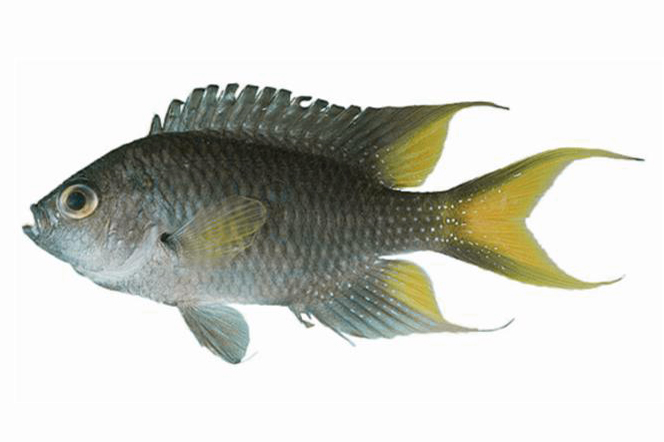Freshwater Demoiselle, Neopomacentrus taeniurus (Bleeker 1856)
Other Names: Blue Ribbon Demoiselle, Freshwater Damsel, Freshwater Damselfish, Fresh-water Demoiselle

Freshwater Demoiselle, Neopomacentrus taeniurus, from Madang, Papua New Guinea, August 1973. Source: John E. Randall / FishBase. License: CC by Attribution-NonCommercial
Summary:
A purplish-brown to greyish-brown damselfish, darker above, with a large dark spot at the origin of the lateral line, dark brown dorsal and anal fins with yellowish rear margins, a pale pectoral fin with a black bar at the base and a dark spot on the upper portion, and a yellowish caudal fin with dark upper and lower margins.
Cite this page as:
Martin F. Gomon, Neopomacentrus taeniurus in Fishes of Australia, accessed 27 Jun 2025, https://fishesofaustralia.net.au/Home/species/367
Freshwater Demoiselle, Neopomacentrus taeniurus (Bleeker 1856)
More Info
|
Distribution |
Occurs in northeastern Queensland from Cooktown to Cairns, and elsewhere in the western Pacific. The species inhabits inshore silty coastal reefs, brackish waters of coastal embayments and mangrove estuaries, and the lower reaches of freshwater streams. |
|
Features |
Dorsal finXIII, 11-12; Anal fin II, 11-12; Caudal fin 13 (branched); Pectoral fin 16-17; LL 15-16; Transverse Scale rows 1-2/1/8-9; Gill rakers (total first arch) 21-23. Body elongate, depth 2.3-2.5 in SL, moderately compressed. Snout short, less than eye diameter. Single nostril on each side of snout. Eye large. Lower edge of suborbital exposed, not hidden by scales, smooth to weakly serrate. Mouth small, oblique, nearly terminal, not reaching to below eye; two rows of teeth in jaws, outer row of larger incisiform teeth with notched or flattened tips and inner row of slender, nearly inconspicuous buttress teeth. Edge of preopercle slightly crenulate to weakly serrate. Scales large, finely ctenoid, covering head and body, except snout tip, chin, lips and isthmus, 27-28 between upper end of opercular opening and base of tail, preopercle with 3-4 scale rows; lateral line gently arched below dorsal fin, ending below soft dorsal. Dorsal fin continuous with elongate base originating above opercular opening, no demarcation between spines and rays. Anal fin with short base below soft portion of dorsal fin. Middle rays of soft dorsal and anal fins and outer rays of caudal frequently produced into long filaments. Caudal fin forked. Pectoral fins slightly rounded. |
|
Size |
To around 7cm SL |
|
Colour |
Purplish-brown to grey-brown, darker dorsally; large dark spot at lateral-line origin; spinous dorsal, pelvic, and anal fins dark brown except hindmost portion of dorsal and anal fins yellowish; pectorals pale with black bar at base and dark spot on upper portion of axil; caudal fin yellowish with dark upper and lower margins. |
|
Feeding |
May feed on zooplankton as do other members of this genus. |
|
Biology |
Oviparous demersal spawners that deposit eggs in nests made on the substrate. |
|
Species Citation |
Pomacentrus taeniurus Bleeker 1856, Act. Soc. Sci. Indo-Neerl. 1: 51. Type locality: Ambon, Indonesia. |
|
Author |
Martin F. Gomon |
Freshwater Demoiselle, Neopomacentrus taeniurus (Bleeker 1856)
References
Allen, G.R. 1991. Damselfishes of the World. Melle, Germany : Mergus Verlag 271 pp.
Allen, G.R. 1991. Field Guide to the Freshwater Fishes of New Guinea. Madang : Christensen Research Institute 268 pp.
Allen, G.R. & Erdmann, M.V. 2012. Reef fishes of the East Indies. Perth : Tropical Reef Research 3 vols, 1260 pp.
Allen, G.R., Midgley, S.H. & Allen, M. 2002. Field Guide to the Freshwater Fishes of Australia. Perth : Western Australian Museum 394 pp.
Bleeker, P. 1856. Beschrijvingen van nieuwe en weinig bekende vischsoorten van Amboina, verzameld op eene reis door den Molukschen Archipel, gedaan in het gevolg van den Gouverneur-Generaal Duymaer van Twist in September en October 1855. Acta Societatis Scientiarum Indo-Neerlandicae 1: 1-76.
Jenkins, A., Myers, R. & Rocha, L.A. 2012. Neopomacentrus taeniurus. The IUCN Red List of Threatened Species 2012: e.T181116A1700196. http://dx.doi.org/10.2305/IUCN.UK.2012.RLTS.T181116A1700196.en. Downloaded on 16 August 2016.
Kuiter, R.H. & Tonozuka, T. 2001. Pictorial guide to Indonesian reef fishes. Part 2. Fusiliers - Dragonets, Caesionidae - Callionymidae. Australia : Zoonetics pp. 304-622.

